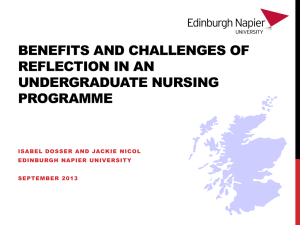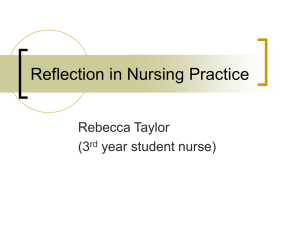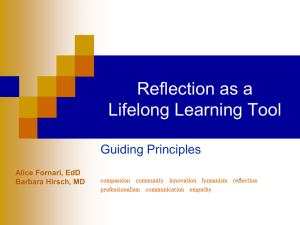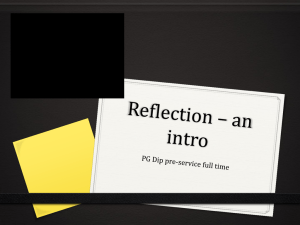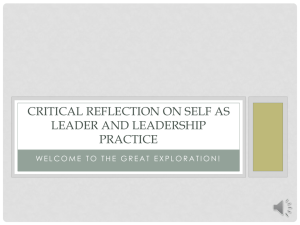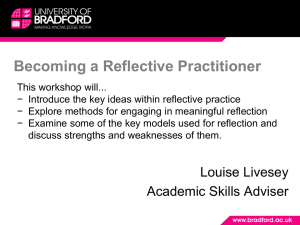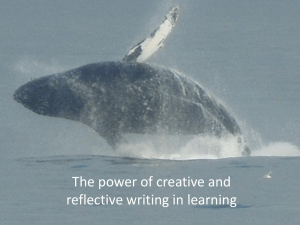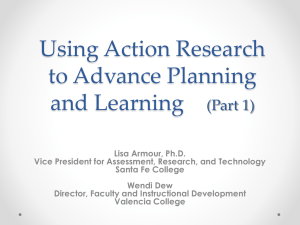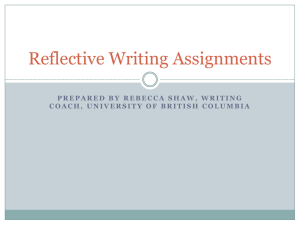Reflective Teaching - Dr.Antar Abdellah Home Page
advertisement
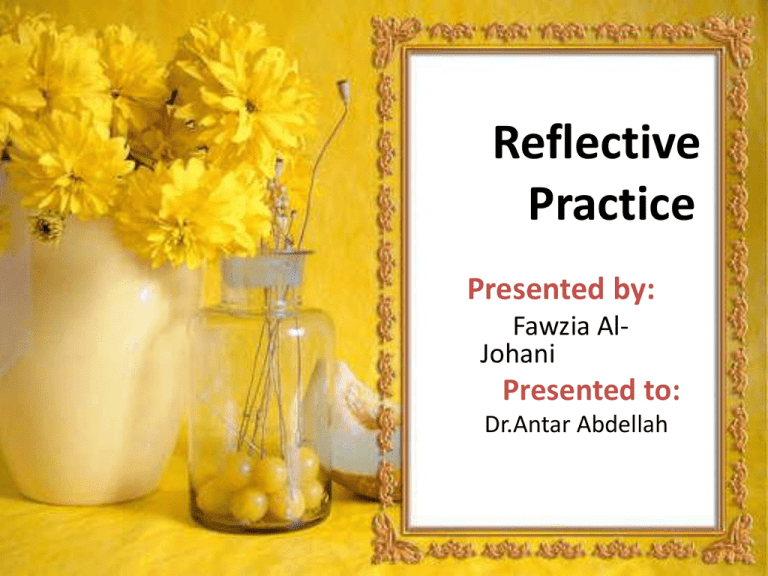
Reflective Practice Presented by: Fawzia AlJohani Presented to: Dr.Antar Abdellah What is reflection: Reflection is a metacognitive strategy that helps teacher ( learner)to think critically upon their experiences and decisions during their teaching or learning practice. A generic term for those intellectual and affective activities in which individual engage to explore their experiences in order to lead to a new understanding and appreciation. Historical roots of reflective teaching: Reflective teaching means: Looking at what you do in the classroom, thinking about why you do it and thinking about if it works. A process of self observation and self evaluation HOW By collecting information about what happened in the classroom. and Analyzing and evaluating this information. Why it is important: Reflective teaching implies more systematic process of collecting , recording and analyzing our thoughts and observations. then Going on to making changes and improvement in our teaching. When to reflect Before an • experience During an • experience Following • an experience Anticipatory reflection Reflection – in -action Reflection – on-action The process of reflecting: Some different ways of doing this: -Gathering information about what happens in the class. Some ways of doing it Teacher diary It is purely personal and writing it requires a certain discipline in taking the time to do it on a regular basis. -After each lesson teacher writes in a notebook about what happened. -Describing his reaction and feeling . -beginning to pose questions about what he had observed. - Peer observation Inviting a colleague to come to the class to collect information about your lesson. -This may be done with simple observation task or note taking. -Fallow up with discussion about what was observed Recording lessons -Video or audio recordings of lessons can provide very useful information for reflection. -Audio recordings can useful for: Considering teacher talk. How much time do you allocate to students talk and how do you respond to students talk? Are instructions and explanations clear? Clinical supervision Is the process wherein the supervisor observes and provides a feed back and discussion . Students feed back You can ask your students what they think about What goes on in the classroom. This can be done with simple questionnaire . Teaching Journal This is a place where you write about your experiences or record some specific teaching events Action research Involve research initiated by the teacher himself or herself in the classroom. He/she identifies an area for investigation ,plans the research and then implements it . Why Is to further an understanding of the teaching and learning process and to bring about some change in classroom practice Action planning Is used at the pre-service level in a number of European countries ,both as a way of assessing students progress and to encourage teachers to reflect Stages of Action planning Review Implement Reflect Plan Portfolios Portfolios and record of achievements are providing a rounded picture of the capabilities of an individual. After collecting information about what goes on in the classroom: What does the teacher do? Think *You may have noticed patterns occurring in your teaching through your observation. *You may also have noticed things that previously unaware of . *You may have been surprised by some of your students’ feedback. Talk Just by talking about what you have discovered to a supportive colleague or even a friend .You may be able to come up with some ideas for how to do things differently. Read You may decide that you need to find out more about a certain area. There are a plenty of ; Websites for English teachers. Magazines for teachers. Books for English language teachers. Ask *Pose questions to websites or magazines to get ideas from other teachers. *If you have a local teachers association or other opportunities for in-service training ,ask for a session on an area that interests you. Using reflective teaching practice in some situations *If a lesson went well . *If the students didn’t understand a language point . Teacher can describe it and think about why it was successful. The teacher needs to think about what he did and why it may have been unclear. *If the students are misbehaving what were they doing ,when and why? Summary Reflective teaching is a cyclical process ,because once you start to implement changes ,then the reflective and evaluation cycle begins again. Reflective learning practice How reflective practice can support and aid learning Process of learning learning is individual. learning is contextual learning is developmental. learning is relational. Reflection helps learners to: Understand what they already • know individual Identify what they • need to know in order to advance understanding of the subject Contextual contextual Make sense of new • information and feedback in the context of their own experience Relational Guide choices for further • learning developmental Reflection involves a dialogue between students and their peers, students and teachers in this point students can make use of feedback from teacher and peers. *-Engaging in a dialogue with others helps students to make sense of what they know. *-Relating the feedback given by others to their current understanding helps students to think about what and how they are learning. Summary “The act of reflecting is one which causes us to make sense of what we’ve learned, why we learned it, and how that particular increment of learning took place. Moreover, reflection is about linking one increment of learning to the wider perspective of learning Benefits of Reflective Practice • 1- Improved teaching practice 2-New learning 3-Enhanced problem solving skill 4-Becoming a critical thinker 5-Making Decision 6-Improved organizational skills 7-Managing personal change 8-Taking your own advice Barriers to reflection Fear of judgment • Fear Of Criticism Defensiveness Professional Arrogance Please rate the following using the scale .4=excellent ,3=very good,2=good,1=poor Statements Information about the topic ( reflective practice ) Allowing enough time for discussion Ensured that everyone can participate Enjoy the presentation 4 3 2 1 The references 1-Tice, J(2011,jun15)Reflective teaching: exploring our own classroom practice. Retrieved November 20,2012,from British Council Website: http://www.teachingenglish.org.uk/articles/reflective-teaching-exploring-our-ownclassroom-practice 2-Hall, S. and Fox, R. (1998). Reflective teaching practice on the web. In Black, B. and Stanley, N. (Eds), Teaching and Learning in Changing Times, 125-132. Proceedings of the 7th Annual Teaching Learning Forum, The University of Western Australia, February 1998. Perth: UWA. http://cea.curtin.edu.au/tlf/tlf1998/hall.html 3-Spoehr,K(2008)Reflective teaching practice ,Students outcomes,and institutional Effectiveness.The teaching Exchange,12,2-6.Retrived from http://www.brown.edu/Administration/Sheridan_Center/pubs/teachingExchange/jan2008/02_sp oehr_reflective_teaching_practices_student_outcomes.pdf 4-How can I introduce reflective practice into my teaching?(2010,June4 ) Retrieved October 12,2012,from The UK center for legal Education Website: http://www.ukcle.ac.uk/resources/personal-development-planning/teaching/ 5-Warwick,P( n.d)Reflective practice: some notes on the development of the notion of professional reflection. Retrieved October 12,2012 from http://www.cumbria.ac.uk/Public/Education/Documents/Research/EducatorsStorehouse/Sharing Ideas/ReflectiveTeachingGuide.pdf • •


